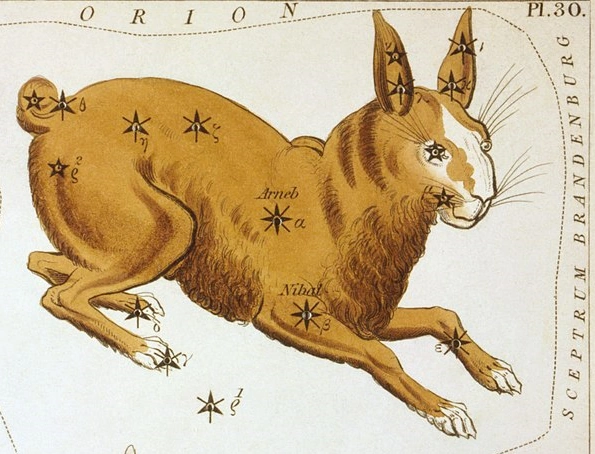This post is for a special friend who recently had trouble locating Hind’s Crimson Star, aka R Leporis.
R Leporis is a famously red carbon star of spectral class C7,4e in the constellation Lepus, the hare. It’s a Mira-type variable 1300 light years from Earth, ranging in magnitude from 5.5 to 11.5, in a period of around 427 days. It was discovered by John Russell Hind in October 1845 from the George Bishop Observatory in Regents Park London, where he was Director from 1844 until 1853. In Star Names: Their Lore and Meaning Richard Hinkley Allen quotes Hind describing it as “like a drop of blood on a black field” (p. 269).

It is shown above in an image from simbad, looking more coppery orange than red as it often does when observed visually. It is claimed by authorities to be either more deeply red when it is near the brighter end of its variable range or conversely near the fainter. I have only ever observed it at 7-8 magnitude, and I’m curious to see how it appears when it is fainter or brighter. David Levy recommends observing it monthly to witness its changes. It may be that to those with smaller telescopes and binoculars the color is more evident when it is brighter, but for those with larger aperture instruments, better able to see it at 10 magnitude or fainter, the red color is more intense when it is fainter. At least that is one explanation for the various of opinions about when its color is most intense.

This chart shows the location of R Leporis near the border with Eridanus. Brilliant Rigel in the south west corner of Orion can be seen at the top middle left. I locate the Crimson star by working west from Mu Leporis, the bright 3rd magnitude star in the Lepus primary asterism. Mu is the right eye of the rabbit in some renderings, but it seems like base of the ears when viewed in the night sky. At any rate, moving west from MU brings one to a parallelogram of 5-6 magnitude stars extending into Lepus from Eridanus. From the northeastern star of the parallelogram (upper left corner), a gentle sweeping arc leads up to R Leporis. The field of view indicator shown in the chart is 3.5 degrees, the view provided by the Oberwerk 20×70 ED Ultra, which is a fine choice for observing this beautiful star.
On evenings when I don’t have hours to spend observing, hopping out with a binocular like the 20×70 ED Ultra on the Oberwerk OB 4000 tripod for a quick peek at something like Hind’s Crimson Star, combined with views of showpieces like M42 in Orion, M35 in Gemini, and M44 in Cancer is a pleasing and fun way to enjoy a quick taste of astronomy before bedtime.


Really pretty star! I liked it A LOT!
Also, when in the area, check out a fun binocular double in: SKF2473
Really enjoyed using your article to find and view this amazing little ruby jewel of a star!!
I’ve observed it a few times now since reading this post, using 15×70 Deluxe and 25×100 Tachyons. Although the Tachyons gave the brighter image, the view wasn’t quite as sharp and the color showed a more orange tint. The Deluxe showed a brilliant blood red star that sparkled like a ruby as it twinkled in the turbulent air!! One of the few times that bad seeing actually made for a more pleasing view.
Astro, thanks for your comment and observing report. 🙂 I occasionally enjoy the subtle CA aura around bright stars when observing with the Deluxe 15×70, accepting it as an aesthetic of the experience. 😉